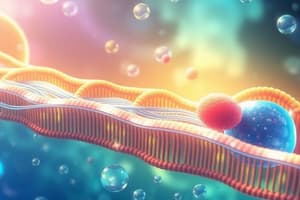Podcast
Questions and Answers
Which of these components is NOT a part of the cell membrane?
Which of these components is NOT a part of the cell membrane?
- Proteins
- Phospholipids
- Carbohydrates (correct)
- Cholesterol
Active transport requires energy to move molecules across the membrane.
Active transport requires energy to move molecules across the membrane.
True (A)
What is the process called when a cell takes in large molecules by engulfing them?
What is the process called when a cell takes in large molecules by engulfing them?
Endocytosis
The movement of water across a semi-permeable membrane from a region of high water concentration to a region of low water concentration is called ______.
The movement of water across a semi-permeable membrane from a region of high water concentration to a region of low water concentration is called ______.
Match the following cell transport mechanisms with their descriptions:
Match the following cell transport mechanisms with their descriptions:
Which of the following is NOT an example of passive transport?
Which of the following is NOT an example of passive transport?
A cell placed in a hypertonic solution will shrink because water moves out of the cell.
A cell placed in a hypertonic solution will shrink because water moves out of the cell.
What is the main reason for using large sample sizes in experiments?
What is the main reason for using large sample sizes in experiments?
Flashcards
Cell Membrane Components
Cell Membrane Components
Phospholipids, proteins, and cholesterol that form and stabilize the membrane.
Semi-Permeable Membrane
Semi-Permeable Membrane
A membrane that allows some molecules to pass while blocking others.
Passive Transport
Passive Transport
Movement of molecules from high to low concentration without energy use.
Active Transport
Active Transport
Signup and view all the flashcards
Endocytosis
Endocytosis
Signup and view all the flashcards
Osmosis
Osmosis
Signup and view all the flashcards
Hypertonic Solution
Hypertonic Solution
Signup and view all the flashcards
Stages of Mitosis
Stages of Mitosis
Signup and view all the flashcards
Study Notes
Cell Membrane
- Composed of a phospholipid bilayer with hydrophilic heads and hydrophobic tails.
- Embedded proteins facilitate transport and communication.
- Cholesterol contributes to membrane stability and fluidity.
- Semi-permeable: Selective in what it allows to pass through.
- Oxygen (O2) and carbon dioxide (CO2) can pass through.
- Large proteins and glucose cannot pass.
- Viruses attach to receptors, enter through endocytosis or membrane fusion to release their genetic material.
Cell Transport
- Passive Transport: No energy needed; movement from high to low concentration (diffusion, osmosis, facilitated diffusion).
- Active Transport: Energy (ATP) required; movement from low to high concentration (endocytosis, exocytosis).
- Endocytosis: Cell takes in large molecules by engulfing them (e.g., white blood cells engulfing bacteria).
- Exocytosis: Cell expels large molecules by fusing vesicles with the membrane (e.g., release of neurotransmitters).
- Diffusion: Movement of molecules from high to low concentration.
- Osmosis: Diffusion of water across a semi-permeable membrane.
- Hypotonic Solution: Lower solute concentration than the cell; water enters, causing swelling.
- Hypertonic Solution: Higher solute concentration than the cell; water exits, causing shrinking.
- Isotonic Solution: Equal solute concentration; no net water movement; cells retain their shape.
- Facilitated Diffusion: Passive transport aided by protein channels.
- Water Movement Across Membranes: Hypertonic: water exits, cell shrinks; Hypotonic: water enters, cell swells; Isotonic: water movement balanced.
Mitosis
- Prophase: Chromosomes condense, nuclear membrane breaks down.
- Metaphase: Chromosomes align in the center of the cell.
- Anaphase: Sister chromatids separate to opposite poles.
- Telophase: Chromosomes reach poles, nuclear membranes reform around each set.
- Cytokinesis: Cytoplasm divides, creating two identical daughter cells.
Cellular Respiration
- Equation: C₆H₁₂O₆ + 6O₂ → 6CO₂ + 6H₂O + ATP
- Purpose: Convert glucose into usable energy (ATP).
- Location: Glycolysis in the cytoplasm; Krebs cycle and electron transport chain in the mitochondria.
Studying That Suits You
Use AI to generate personalized quizzes and flashcards to suit your learning preferences.



